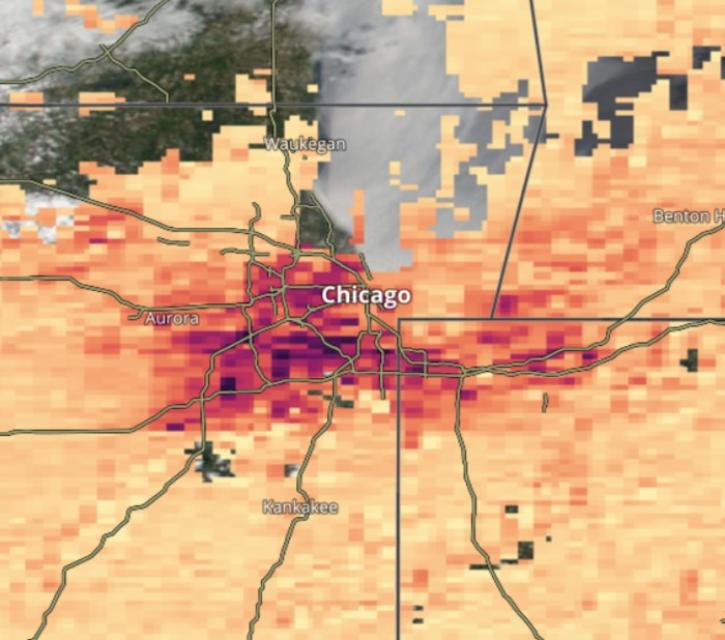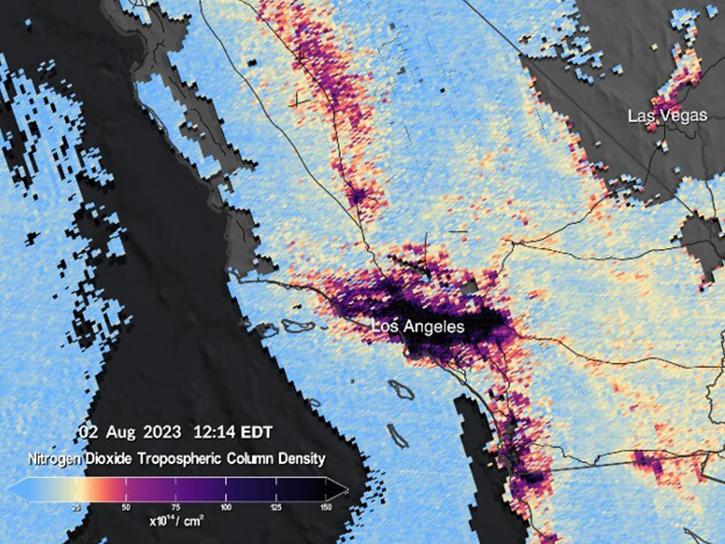Nitrogen Dioxide Data Access and Tools
Access topic-specific data and resources for accessing, visualizing, preparing/manipulating (e.g. subsetting), and analyzing data. Each observation, model, and reanalysis data has unique characteristics that should be considered when evaluating its use.
An asterisk (*) next to an entry indicates that near real-time (NRT) data products are available through NASA's Land, Atmosphere Near real-time Capability for Earth observation (LANCE). While not intended for scientific research, NRT data are good resources for monitoring ongoing or time-critical events. Learn more about the difference between near real-time versus standard products.
Commonly Used Nitrogen Dioxide Data at a Glance
| Spatial Resolution | Spatial Coverage | Temporal Resolution | Temporal Coverage | Spectral Resolution | Satellite/ Platform | Name (Instrument, Model, etc.) | Observation, Model, or Reanalysis | File Format |
|---|---|---|---|---|---|---|---|---|
| 0.25°, 13 km x 24 km | Global | 98 min, Daily | 2004-near present | 1.0-0.45 nm Full Width and Half Maximum (FWHM) | Aura | Ozone Monitoring Instrument (OMI) | Observation | HDF-EOS5 |
| 5.5 km x 3.5 km | Global | 101.5 minutes | 2021-present | 270 nm-2.3 µm, 0.55 nm | ESA Sentinel-5P | TROPOspheric Monitoring Instrument (TROPOMI) | Observation | netCDF |
| 2.0 km x 4.75 km | North America | Hourly | 08/2023 - present | 0.6 nm | Intelsat 40e | Tropospheric Emissions: Monitoring Pollution (TEMPO) | Observation | netCDF |
| 0.25º x 0.25° | Global | 15 min, Hourly | Daily 5-day forecast | N/A | N/A | GEOS-CF | Model | netCDF |
| 0.0083° x 0.0083° | Near-global | Yearly | 1990-2020 | N/A | N/A | LUR | Model | netCDF |
| Point measurements | Global | Periodic flights occurred during each deployment | 2016-2018 | Varies | Airborne Field Campaign | Atmospheric Tomography Mission (ATom) campaign with varying instruments | Observation | netCDF |
Nitrogen Dioxide Datasets
| Dataset | Platforms | Instruments | Temporal Extent | Location Keywords | Spatial Extent | Data Format |
|---|---|---|---|---|---|---|
| ABLE-3A Electra In-Situ Trace Gas Data | NASA ELECTRA | GAS CHROMATOGRAPHS, GRAB SAMPLERS, LIF-NO | 1988-07-07 to 1988-08-18 | NORTH AMERICA, ALASKA, VIRGINIA, GREENLAND, WESTERN HEMISPHERE | N: 83.332 S: 37.082 E: -55.443 W: -168.402 | GTE |
| ABLE-3A Ground Data | GROUND-BASED OBSERVATIONS | Harvard CO2 | 1988-07-07 to 1988-08-18 | NORTH AMERICA, ALASKA, VIRGINIA, GREENLAND, WESTERN HEMISPHERE | N: 83.332 S: 37.082 E: -55.443 W: -168.402 | GTE |
| ACCLIP WB-57 Aircraft In-situ Trace Gas Data | NASA WB-57F | ACOS, COMA, LIF-NO, LIF-SO2, ISAF, COLD 2, UASO3 | 2022-07-14 to 2022-09-14 | ASIA, EASTERN ASIA, SOUTHEASTERN ASIA, SOUTHERN ASIA, PACIFIC OCEAN | ICARTT | |
| ACCLIP WB-57 Aircraft Merge Data | NASA WB-57F | Computer | 2022-07-16 to 2022-09-14 | ASIA, SOUTHEASTERN ASIA, SOUTHERN ASIA, PACIFIC OCEAN, WESTERN PACIFIC OCEAN | N: 61.5 S: 16.6 E: 180 W: -180 | ICARTT |
| ARCTAS DC-8 Aircraft In-situ Photolysis Rate Data | NASA DC-8 | CAFS | 2008-03-17 to 2008-07-14 | TROPOSPHERE, STRATOSPHERE, CANADA, UNITED STATES OF AMERICA, WESTERN HEMISPHERE | ICARTT | |
| ARCTAS DC-8 Aircraft In-situ Trace Gas Data | NASA DC-8 | TOGA, GAS CHROMATOGRAPHS, ATHOS, HOxCIMS, TD-LIF, DACOM, DIAL, CIMS, FLUORESCENCE SPECTROSCOPY, NDIR GAS ANALYZER, NOxyO3, PTR-MS | 2008-03-18 to 2008-07-14 | CANADA, UNITED STATES OF AMERICA, NORTH AMERICA, WESTERN HEMISPHERE, NORTHERN HEMISPHERE | ICARTT | |
| ARCTAS Model Data | CLIMATE MODELS, GEOS-5, GEOS-Chem | Computer | 2008-03-30 to 2008-07-14 | NORTH AMERICA, CANADA, UNITED STATES OF AMERICA, WESTERN HEMISPHERE, MID-LATITUDE | netCDF-3, ICARTT | |
| ARCTAS P-3B Aircraft AATS14 Data | P-3B | AATS14 | 2008-03-25 to 2008-07-13 | NORTH AMERICA, CANADA, UNITED STATES OF AMERICA, WESTERN HEMISPHERE, NORTHERN HEMISPHERE | ICARTT | |
| ARISE 2014 C-130 Remotely Sensed Aerosol and Trace Gas Data | C-130 | 4STAR | 2014-08-30 to 2014-10-05 | CONTINENT, NORTH AMERICA, UNITED STATES OF AMERICA, ALASKA, GEOGRAPHIC REGION | ICARTT | |
| ARISE C-130 Aircraft Merge Data Files | C-130 | Computer | 2014-08-30 to 2014-10-06 | CONTINENT, NORTH AMERICA, GREENLAND, UNITED STATES OF AMERICA, ALASKA | ICARTT |
Frequently Asked Questions
Earthdata Forum
Our online forum provides a space for users to browse thousands of FAQs about research needs, data, and data applications. You can also submit new questions for our experts to answer.
Submit Questions to Earthdata Forumand View Expert Responses


